As dog owners, we are often touched by the gentle nuzzling of our furry companions, but have we truly deciphered the complexity of this behavior?
While nuzzling may seem like a simple act of affection, its layers go beyond mere cuddles and pets. Understanding the subtleties of why dogs nuzzle can unveil a whole new world of communication and connection between humans and their canine counterparts.
Let's unravel the intricate web of meanings behind your dog's nuzzles to gain a deeper insight into the rich tapestry of emotions and needs they seek to express.
Key Takeaways
- Dog nuzzling serves as a form of communication and expression of feelings.
- Nuzzling can indicate health issues or anxiety in dogs.
- Understanding a dog's nuzzling behavior is crucial for their well-being.
- Consulting a vet or behavior expert is advisable for persistent nuzzling issues.
Reasons for Dog Nuzzling
When considering the behavior of dog nuzzling, it is essential to understand that this action serves as a vital form of communication and information gathering, particularly ingrained in dogs from a young age.
Dogs nuzzle not only to express affection but also to convey needs, wants, and feelings. It is a way for them to establish connections, seek attention, and strengthen bonds with their owners and other animals.
Additionally, nuzzling can be a method for dogs to identify scents, gather information about their environment, and even communicate health issues such as itchiness or anxiety. Therefore, interpreting a dog's nuzzling behavior is crucial for understanding their emotional state and overall well-being.
Mother-Dog Nuzzling Techniques
Mother dogs employ intricate nuzzling techniques to care for and interact with their puppies, showcasing a remarkable display of maternal instincts and communication skills. These techniques play a crucial role in fostering the bond between mother and offspring. Here is a breakdown of some common mother-dog nuzzling techniques:
| Nuzzling Technique | Description | Purpose |
|---|---|---|
| Licking | Gentle licking of puppies' faces and bodies | Cleaning and grooming |
| Snout nudging | Using the nose to move or position the puppies | Ensuring safety and comfort |
| Soft vocalizations | Making soft sounds while nuzzling | Providing comfort and reassurance |
| Tail wagging | Wagging the tail during nuzzling interactions | Expressing affection and happiness |
Puppy Nuzzling Behaviors
Puppy nuzzling behaviors display a fundamental aspect of canine communication and bonding that stems from maternal care techniques.
- Scent Identification: Puppies nuzzle to identify their littermates and mother through scent.
- Comfort Seeking: Nuzzling against a warm body provides comfort and security for young puppies.
- Bonding Ritual: Nuzzling is a bonding ritual that fosters social connections within the litter.
- Exploratory Behavior: Puppies nuzzle to explore their environment and learn about textures and objects.
- Mimicking Mother: By nuzzling, puppies mimic the comforting actions of their mother, promoting a sense of security and well-being.
Expressive Nuzzling in Dogs
Exploring the nuanced expressions of nuzzling behavior in dogs reveals insights into their emotional and communicative capacities. Dogs exhibit various forms of expressive nuzzling, each carrying its own message. From seeking attention to displaying affection, dogs use nuzzling as a powerful tool for communication. Below is a table highlighting some common expressive nuzzling behaviors in dogs:
| Nuzzling Behavior | Meaning | Example |
|---|---|---|
| Gentle head nuzzling | Affection and bonding | Nuzzling against your hand for petting |
| Persistent body nuzzling | Seeking attention | Nuzzling your leg repeatedly for playtime |
| Circular nuzzling motion | Comfort or relaxation | Nuzzling in a circular motion before lying down |
| Nose-to-nose nuzzling | Reassurance or greeting | Nuzzling another dog upon meeting |
Health-Related Nuzzling Signs
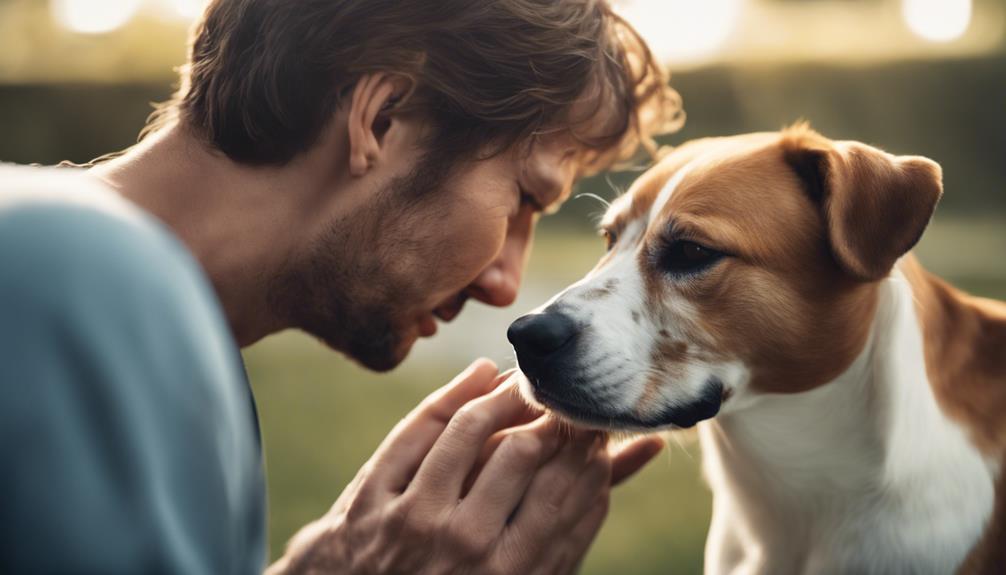
Understanding a dog's nuzzling behavior can also provide valuable insights into their overall health, particularly in identifying potential signs related to their well-being. Here are some health-related nuzzling signs to be aware of:
- Allergies: Excessive nuzzling or rubbing against objects may indicate allergies.
- Ear Infections: Persistent nuzzling around the ears could signal an ear infection.
- Dental Issues: Increased nuzzling near the mouth may suggest dental problems.
- Pain: Nuzzling a specific area repeatedly might indicate pain or discomfort.
- Skin Irritations: Excessive nuzzling or scratching may be a sign of skin irritations or infections.
Dealing With Chronic Nuzzling Issues
Addressing chronic nuzzling issues in dogs requires a comprehensive assessment of potential underlying causes and appropriate interventions. Persistent nuzzling behaviors can stem from various reasons such as underlying medical conditions, anxiety, or a learned behavior.
Seeking guidance from a veterinarian or a professional behavior expert is crucial to identify the root cause of excessive nuzzling. A thorough physical examination can help rule out any health issues contributing to the behavior.
Additionally, creating a safe and comfortable environment for the dog, providing mental and physical stimulation, and establishing consistent routines can aid in managing chronic nuzzling problems. Understanding the individual dog's needs and addressing them appropriately is essential for fostering a harmonious relationship and ensuring the well-being of the pet.
Nuzzling and Anxiety in Dogs
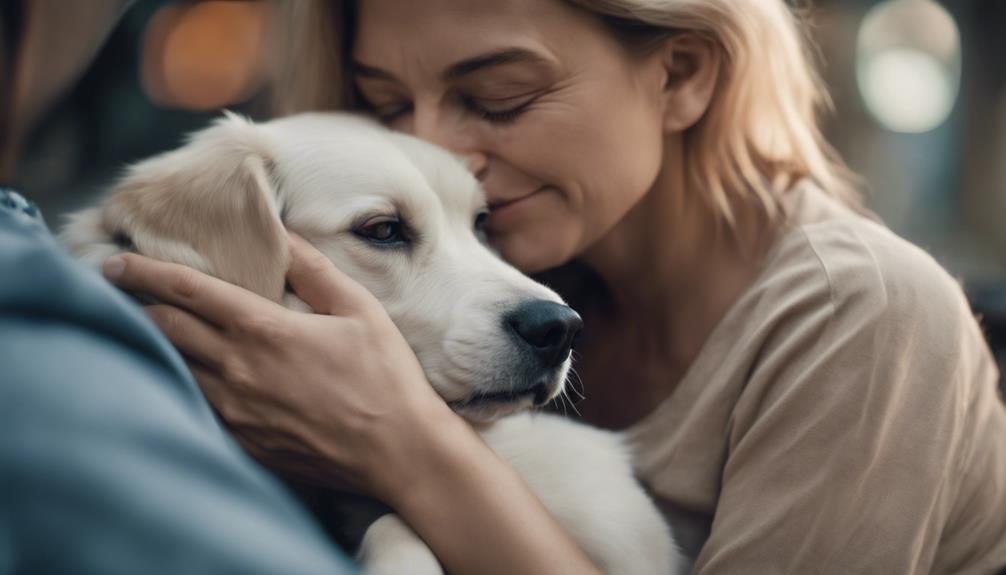
Chronic nuzzling behavior in dogs can often be a sign of underlying anxiety that warrants careful attention and proper evaluation. Dogs may exhibit increased nuzzling tendencies when feeling stressed, fearful, or insecure. Understanding the connection between nuzzling and anxiety can help pet owners provide appropriate support and interventions. Here are some key points to consider:
- Monitor nuzzling frequency and intensity to assess anxiety levels.
- Identify potential triggers or stressors that may be causing anxiety in your dog.
- Seek guidance from a veterinarian or animal behaviorist for professional evaluation.
- Implement calming techniques like interactive play, mental stimulation, or comforting routines.
- Avoid reinforcing anxious behavior through excessive attention or coddling.
Seeking Professional Nuzzling Advice
When faced with persistent nuzzling behaviors in dogs that indicate potential anxiety issues, seeking professional advice from a veterinarian or certified animal behaviorist is essential for accurate assessment and tailored intervention strategies. These experts can help decipher the underlying reasons for the nuzzling and provide guidance on how to address any concerns effectively. Below is a table outlining the benefits of seeking professional nuzzling advice:
| Benefits of Seeking Professional Advice |
|---|
| Accurate assessment of behavior |
| Tailored intervention strategies |
| Expert guidance on addressing concerns |
Decoding Dog Nuzzling
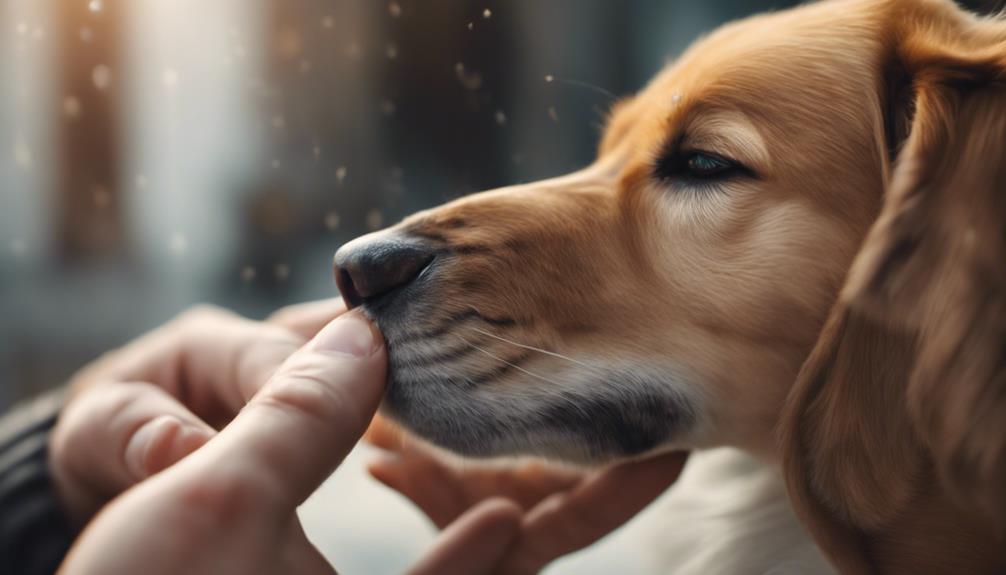
Understanding the intricacies of dog nuzzling behavior is essential for fostering a strong bond and ensuring the well-being of our canine companions. Decoding a dog's nuzzling can provide valuable insights into their thoughts and feelings, aiding in effective communication and relationship-building.
When observing your dog's nuzzling actions, consider the following key points:
- Pay attention to the context in which the nuzzling occurs.
- Observe your dog's body language and overall demeanor during nuzzling.
- Take note of any specific triggers or stimuli that prompt nuzzling behavior.
- Consider the duration and intensity of the nuzzling gestures.
- Seek professional advice if you have concerns about your dog's nuzzling habits.
Sight and Smell in Nuzzling
Dogs rely on their acute senses of sight and smell to engage in nuzzling behavior, which plays a crucial role in their communication and interaction with their environment. Their keen sense of smell allows them to gather information about their surroundings and other animals. When a dog nuzzles, it is not only exploring the object or person but also learning about their scent profile.
Additionally, dogs use their sight to observe body language and facial expressions, helping them understand the emotions and intentions of those they are nuzzling. This combination of sight and smell enhances their ability to communicate effectively and build connections with their environment and the individuals within it. Understanding how dogs utilize these senses in nuzzling can deepen the bond between humans and their canine companions.
Nuzzling Mechanics Explained
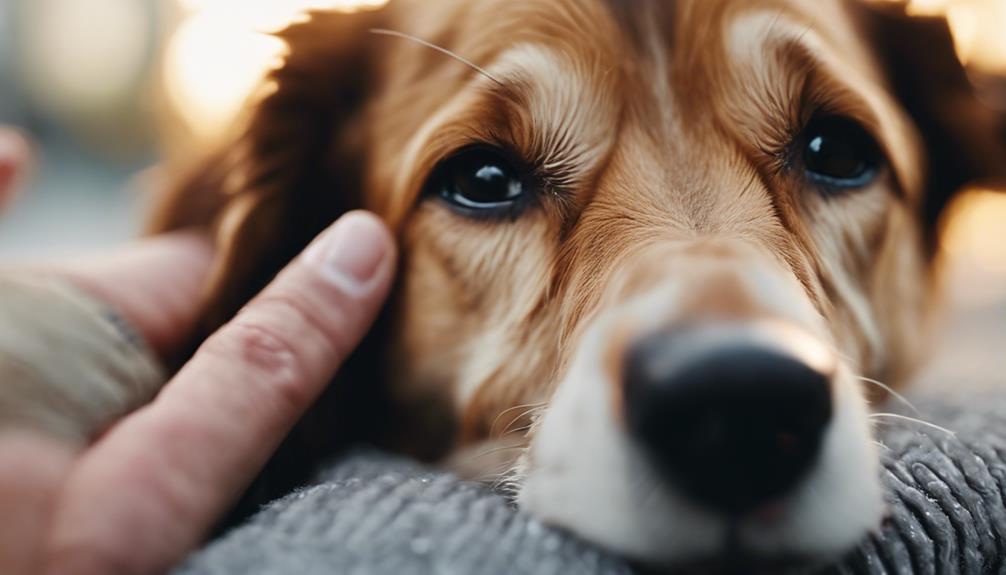
Utilizing their sensitive noses and gentle touches, dogs employ intricate mechanics during nuzzling interactions to convey emotions and gather information effectively. When dogs nuzzle, they engage in a series of actions that serve various purposes:
- Nuzzling involves soft nudges and gentle head movements.
- Dogs may lick or softly mouth the recipient during nuzzling.
- They often emit calming signals like slow blinks or relaxed body posture.
- Dogs may vary the pressure of their nuzzles based on the recipient's response.
- Nuzzling can be accompanied by vocalizations such as soft whines or contented sighs.
Nuzzling Preferences With Strangers
When encountering unfamiliar individuals, dogs exhibit varying degrees of preference for engaging in nuzzling interactions. Some dogs may readily approach strangers for nuzzling, showing a friendly and sociable nature. These dogs are typically outgoing and enjoy making new connections.
On the other hand, some dogs may be more reserved and cautious around strangers, preferring not to engage in nuzzling until they feel comfortable and secure in the new environment. This behavior can stem from a natural wariness or a past negative experience with unfamiliar individuals.
It is essential for pet owners to respect their dog's preferences and boundaries when it comes to nuzzling with strangers, allowing the dog to approach new individuals at their own pace.
Understanding Comfort Levels in Nuzzling
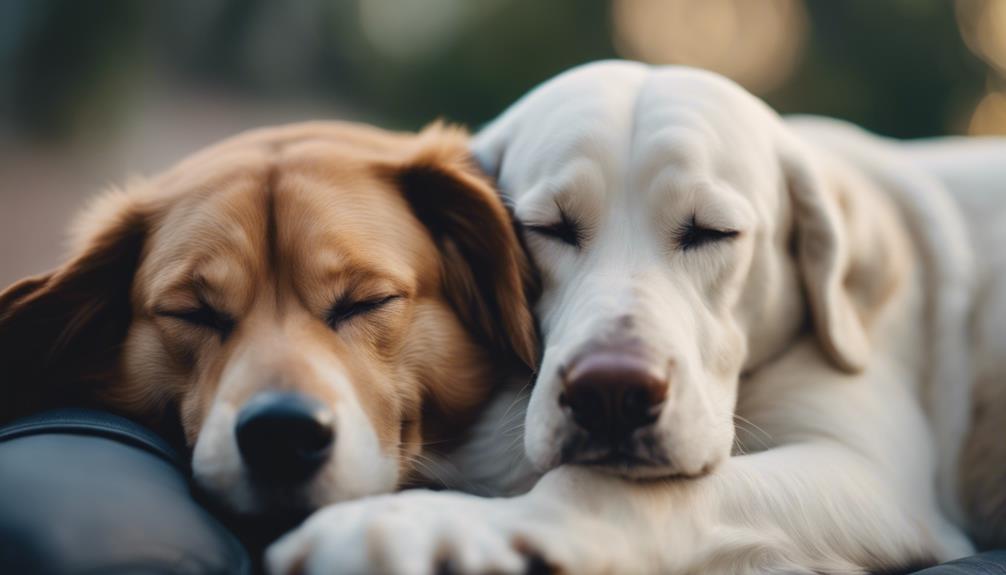
Exploring the nuances of nuzzling interactions can provide valuable insights into dogs' comfort levels and preferences in social interactions. Dogs communicate through various behaviors, and nuzzling is a key indicator of their comfort and trust levels. Understanding these cues can help strengthen the bond between dogs and their human companions.
To comprehend dogs' comfort levels in nuzzling, consider the following:
- Pay attention to the dog's body language during nuzzling interactions.
- Respect the dog's personal space and boundaries.
- Observe how the dog responds to different types of nuzzling.
- Take note of any signs of stress or discomfort exhibited by the dog.
- Seek guidance from a professional trainer or behaviorist if unsure about interpreting the dog's nuzzling behavior.
Conclusion
In conclusion, dog nuzzling is a complex behavior that serves as a form of communication between dogs and their human companions.
From seeking affection to expressing discomfort, nuzzling conveys a range of emotions and needs.
By understanding the various meanings behind this behavior, dog owners can deepen their bond with their furry friends and enhance their relationship based on empathy and mutual understanding.




